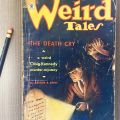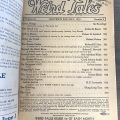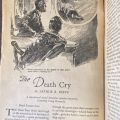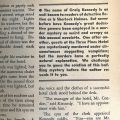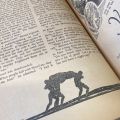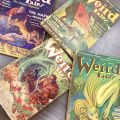During the Spring 2023 semester, Special Collections & Archives collaborated with Dr. Colleen Tripp's English 630, "Modern Monsters: Then & Now." Students in the class selected items from our collections of pulps, comics, and horror stories, then authored a series of blog posts in which they examined visual and other representations of the monstrous in the texts they chose. This is the first post of eight in the series.
We begin with a background of darkness, a void from which there is no beginning or end. Yet here, in the middle of all that is and never was, a man is able to pierce through both darkness and time itself to illuminate for us with his flashlight… a gravestone. “Gypsy Jones. Born, Died. So I have lived unknown, So shall I die unknown.” In this world absent of light, his illumination is not entirely welcome, and behind him, a figure of this world who is thus cloaked by it stands ready to take his life. And beside them, the title of the issue’s most prominent story: “The Death Cry,” promised as “a weird Craig Kennedy murder-mystery.”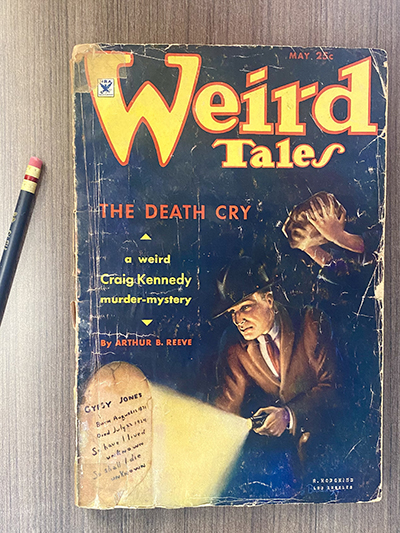
Welcome… to Weird Tales.
Initially founded in 19231, the Weird Tales pulp magazine boasts an impressive lineup throughout its just over thirty year run, having been one of the first places where American audiences could be introduced to later sci-fi staples such as Cthulu2 and Conan the Barbarian3. Weird Tales was one of the first magazines of its kind, publishing exclusively horror and sci-fi tales, and was even the starting point for several authors who later became household names, such as Ray Bradbury and Robert E. Howard4. It is also, sorrowfully enough, the resting place for a great many characters made popular by the pulps themselves, including the advertised character in this edition’s titular story, Craig Kennedy. He’s often described as the American answer to Sherlock Holmes, as he was a particularly popular detective character who shared a lot of similar characteristics with Holmes, such as an all-around lack of humility and a penchant for solving crimes through up-and-coming technology that would have been considered advanced at the time of his publication, such as lie detectors and gyroscopes5. First featured in the December 1910 edition of Cosmopolitan magazine (yes, that Cosmopolitan)6, the character of Craig Kennedy quickly gained a massive audience, with more than a couple dozen books and over 100 short stories throughout the twenty years of his peak popularity. However, Craig Kennedy did not survive the decline of the pulp magazine that happened as the U.S. headed into World War II7, and the story in which he is featured in this issue was actually his second to last appearance in the written form, and his final short story. Which, one has to admit, makes this cover art particularly ironic.
Ironic predictions of a character’s future aside, the cover of the May 1935 edition of Weird Tales is unique in that its art is one of the few issues which does not portray some type of alien or monstrosity. Our main character is illuminated, front and center, clearly visible as is the grave marking he’s examining yet all we see of the enemy, of the “monster,” is human hands holding a boulder, ready to bring it down onto his skull. Obviously, to reveal the owner of the hands would be to give away the mystery of the story entirely, but there’s something fascinating in refusing to portray this instance of human monstrosity. Amongst the countless other monster portrayals that cover the hundreds of issues of Weird Tales, this one stands out amongst them for its refusal to participate in revealing the monster.
But of course, given the general idea and fear around monsters, the concealing of a more human “monster” makes sense. According to Jeffrey Jerome Cohen, in his analysis of several theories on the portrayal of the monstrous, the monster is supposed to, “dwell at the gates of difference,”8 or rather, the monster represents some form of Otherness that the general populace fears. This type of monstrosity is most obvious when we dwell upon the uncanny valley, wherein the monster is similar enough so much as to appear human, but minute differences in the way they present themselves turn the familiarity of another human face into the fear and terror of something strange. The emphasis here, in this theory of course, is on the word different. The monster is different and therefore the monster cannot be us, because if the monster were not different then the monster would be us, and humans can hardly stand to look in a mirror and realize the darker parts of themselves. The monster that would be on the cover of Weird Tales were they to be depicted, would be human, thus all of us would be monsters. Instead, we have only hands to represent the antagonistic force, which are even shunted off to the side of the cover so that, even if there were to be a depiction, there is no room within the image to accommodate any significant part of them.
This is, of course, brightly contrasted by the “truly” human character on the cover, our main detective Craig Kennedy who is, quite literally, shedding light on the situation. Our hero is front and center, the source of light in the scene, the only being that can pierce through the darkness that surrounds him. It isn’t exactly subtle, but pulp magazines weren’t famed for their subtle, highbrow literature. Even so, there’s an emphasis on the illumination of his face that doesn’t quite make sense for where his flashlight is pointed - it’s almost as if there is some additional light that is shining on his face, making sure you can see every detail of his clean-shaven face, his concentrated expression, unknowing of the danger that lurks just behind him. He is, quite literally, the light in the dark, overly emphasized in comparison to the human monster hiding just inside of the cover. The only way to “reveal” the monster within is not to casually glance over the magazine, but to open and read - if you dare face what you might find.
1. “About.” Weird Tales, Weird Tales Inc., 2019, https://www.weirdtales.com/about.
2. “Weird Tales.” The Encyclopedia of Science Fiction, SFE Ltd., 21 Apr. 2021, https://sf-encyclopedia.com/entry/weird_tales.
3. Kuiper, Kathleen. “Conan the Barbarian.” Encyclopedia Britannica, Encyclopedia Britannica, Inc., 7 May 2010, https://www.britannica.com/topic/Conan-the-Barbarian-fictional-character.
4. “Weird Tales.”
5. Reeve, Arthur B. “The Case of Helen Bond.” Cosmopolitan, Dec. 1910: 113.
6. “Pulp Illustration: Pulp Magazines.” Illustration History, Norman Rockwell Museum, https://www.illustrationhistory.org/genres/pulp-illustration-pulp-magazines.
7. Haining, Peter. The Classic Era of Crime Fiction. Chicago Review Press, 2002: 73-4.
8. Cohen, Jeffrey Jerome. “‘Monster Culture (Seven Theses).’” Classic Readings on Monster Theory: Demonstrare, Volume One, edited by Asa Simon Mittman and Marcus Hensel, Arc Humanities Press, 2018. JSTOR, https://doi.org/10.2307/j.ctvfxvc3 p.10: 43-54.



